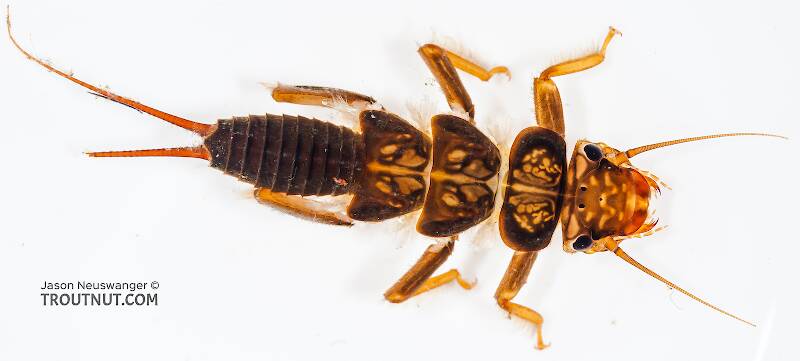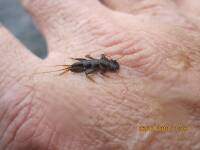
Blue-winged Olives
Baetis
Tiny Baetis mayflies are perhaps the most commonly encountered and imitated by anglers on all American trout streams due to their great abundance, widespread distribution, and trout-friendly emergence habits.
Featured on the forum

Troutnut is a project started in 2003 by salmonid ecologist Jason "Troutnut" Neuswanger to help anglers and
fly tyers unabashedly embrace the entomological side of the sport. Learn more about Troutnut or
support the project for an enhanced experience here.
GONZO on Apr 3, 2007April 3rd, 2007, 5:00 am EDT
This appears to be Acroneuria. Not sure which species.
GONZO on Apr 3, 2007April 3rd, 2007, 5:53 am EDT
Sorry, Jason--hasty judgement. This specimen appears to have a setal row across the occiput. Probably Paragnetina media. I'm not used to seeing a distinct "W" on the head of media, so this one threw me. But, I can't think what else it could be. (Way too dark for immarginata, and the abdomen would be patterned.)
Mlajoie
Posts: 6
Posts: 6
Mlajoie on Mar 18, 2008March 18th, 2008, 4:49 am EDT
This may in fact be media, but Gonzo is right, the markings are usually not this distinct (especially the 'w'). To me, this looks more like a darkly colored immarginata. Differences of habitat frequently cause variations in color, and it is tough to distinguish for sure, based on the photos. Immarginata has transverse banding on the abdominal terga, and this specimine has an especially dark abdomen, making it hard to tell. Also, just to point out, Gonzo, the occipital ridge is not made up of setae. It is a closely set transverse row of spinules. And to the other comment, a golden nymph will work fine for fishing, as it's still a perlid. Besides, I don't think trout can ID to species...
Entoman on Mar 11, 2012March 11th, 2012, 5:12 am EDT
Jason,
This one is still linked with Acroneuria for some reason, even though the name is now correct.
Two characters that nobody seems to mention are the concave look to the back of the head (caused by the occiputal ridge) and the exaggerated bowling pin shape of the abdomen on many Paragnetina. These are noticable differences from Acroneuria. When these two characters are together and obvious, there should be no need to look at spinules with a microscope or good macrophoto to determine between the two. We have a similar situation out West with Callineuria/Hesperoperla and Claassenia nymphs. Astute observers can easily tell the difference at a glance without enhanced vision, and I suspect this may also be possible between many if not most Acroneuriinae and Perlinae genera in the East.
This one is still linked with Acroneuria for some reason, even though the name is now correct.
Two characters that nobody seems to mention are the concave look to the back of the head (caused by the occiputal ridge) and the exaggerated bowling pin shape of the abdomen on many Paragnetina. These are noticable differences from Acroneuria. When these two characters are together and obvious, there should be no need to look at spinules with a microscope or good macrophoto to determine between the two. We have a similar situation out West with Callineuria/Hesperoperla and Claassenia nymphs. Astute observers can easily tell the difference at a glance without enhanced vision, and I suspect this may also be possible between many if not most Acroneuriinae and Perlinae genera in the East.
"It's not that I find fishing so important, it's just that I find all other endeavors of Man equally unimportant... And not nearly as much fun!" Robert Traver, Anatomy of a Fisherman
Quick Reply
Related Discussions
Topic
Replies
Last Reply
4
Mar 11, 2012
by Entoman
by Entoman
2
Jan 19, 2010
by Dkak
by Dkak
0
Apr 8, 2013
by Entoman
by Entoman
1
Oct 28, 2008
by GONZO
by GONZO
Re: Helopicus subvarians (Stonefly) common in New York waters!
In the Stonefly Genus Helopicus by Walleye
In the Stonefly Genus Helopicus by Walleye
6
Jan 9, 2014
by Entoman
by Entoman





